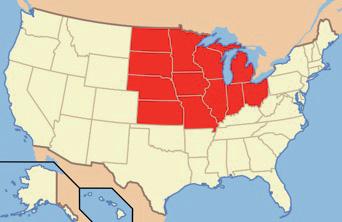
3 minute read
New Route
NEW OPTION FOR HOLY GRAIL
The traditional option from East Canada ports to discretionary hinterlands is intermodal rail. However, another option now exists. AJ Keyes investigates
The ability to eff ectively serve the US Midwest can be regarded as something of a “Holy Grail” for the North American container port industry. So, any option that off ers a benefi cial, cost-eff ective or more environmentally-friendly option to reach this massive consuming and producing area is going to appeal to both cargo owners and shipping lines.
Almost all major ports in Canada and the USA either compete to serve, or have a desire to access, the largescale consuming hinterlands that stretch from the Great Lakes, down the Ohio Valley. According to the US Census Bureau this is a largescale area covering 12 different states, as shown in Figure 1.
The traditional approach for ports throughout North America is to utilise intermodal rail to cover the significant distances involved, either from US/Canada West Coast ports or from the Atlantic. For Halifax and Montreal in East Canada this means a reliance on service provided primarily by Canadian National Railway (CN) and also Canadian Pacific Railroad (CPR).
Is intermodal rail, however, the only option available? Potentially not.
THE CLEVELAND ANGLE
Serving the US Midwest via Cleveland, USA may not seem like an obvious solution, but with the distances for existing routes such as New York/New Jersey, Virginia and Halifax too far for trucking and heavily reliant on intermodal rail only, perhaps some shippers and beneficial cargo owners will welcome an alternative option? Cleveland is located along the southern shore of Lake Erie, across the U.S. maritime border with Canada
“Using the Cleveland feeder option enables cargo to benefit from our lack of congestion, ease of movement when cargo is discharged and moves out the gate, and our proximity to the major manufacturing base of the USA within an eight-hour drive of our port,” explains David S. Gutheil, Chief Commercial Officer, Port of Cleveland.
His view is endorsed by Dean Davison, Technical Director, WSP UK Ltd. “A feeder service of 1200TEU linking Montreal to Cleveland offers shippers and cargo owners an environmentally-friendly alternative to intermodal rail or road to New York/New Jersey, Baltimore and Virginia. Analysis of the costs involved confirm that the Cleveland Feeder service via Montreal compared to a US Northeast port, is the most cost-effective outcome for key destinations including Cleveland, Columbus, Akron, Toledo, Indianapolis and Detroit.”
CHALLENGES?
So, if the Cleveland option offers a cost-effective cargo routing to key areas and one that is more environmentallyfriendly, what challenges exist to this option becoming a more mainstream choice? The largest factor is shipping line and cargo owner inertia.
Unless there is a good reason, or need to do so, cargo shippers and shipping lines will often not wish to change the status quo. There must also be sufficient volumes to make any logistics changes too.
The routing is also usually closed for three months during winter, although innovative solutions to maintain weekly services can overcome this issue.
Clearly, the Cleveland option does hold some merit, as Davison explains: “The facility is congestion free and by the time the containers arrive, via an environmentally-friendly waterway routing, the cargo is already much closer to the final markets. For some shipping lines and beneficial cargo owner partners, this could be an appealing combination.”
8 Figure 1: US
States Defi ned as the Midwest Region
Canadian Domestic Options Growing
Canadian shipping firm Desgagnés has launched a domestic container service between Montreal, Quebec, and Hamilton, Ontario. Desgagnés operates this service in partnership with the Hamilton Oshawa Port Authority (HOPA Ports) and the Hamilton Container Terminal.
The new line is backed by cargo contracts from MSC. The service will be operated through the St Lawrence Seaway System, using the 12,600 dwt, Desgagnés-controlled, general cargo vessel SEDNA DESGAGNES which is able to carry up to 665TEU. A first departure from Hamilton set sail on 11 June.
Hamilton is based at the Western tip of Lake Ontario, sitting 600 km south west of Montreal. The port handles cargoes originating from/going to the Great Toronto and Hamilton (GTHA) area. The new service aims at tapping into this market, with cargoes transshipped in Montreal to/from long haul international liner services.
The Desgagnés/HOPA/HCT service is the second regular container line initiative launched in the Canadian domestic trade in recent months. In March 2021, another Canadian operator, Doornkamp Lines announced the start of a regular container service connecting Halifax (Nova Scotia) to Picton (Ontario).











